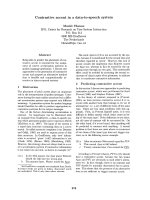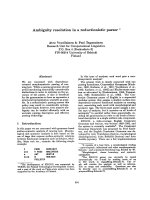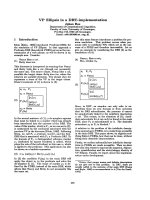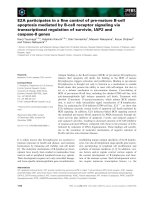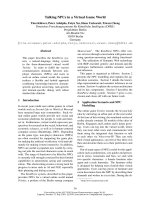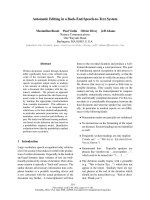Báo cáo khoa học: " Arachnoid cyst in a patient with psychosis: Case report" pps
Bạn đang xem bản rút gọn của tài liệu. Xem và tải ngay bản đầy đủ của tài liệu tại đây (276.67 KB, 6 trang )
BioMed Central
Page 1 of 6
(page number not for citation purposes)
Annals of General Psychiatry
Open Access
Case report
Arachnoid cyst in a patient with psychosis: Case report
Joaquim Alves da Silva*
1
, Alexandra Alves
2
, Miguel Talina
1
, Susana Carreiro
2
,
João Guimarães
3
and Miguel Xavier
1
Address:
1
Depart. Psychiatry and Mental Health, Faculty Medical Sciences – UNL Calçada da Tapada, 155, 1300-Lisbon, Portugal,
2
Depart.
Psychiatry – Hospital S. Francisco Xavier, 1400-Lisbon, Portugal and
3
Depart. Neurology, Faculty Medical Sciences – Hospital Egas Moniz, 1400-
Lisbon, Portugal
Email: Joaquim Alves da Silva* - ; Alexandra Alves - ;
Miguel Talina - ; Susana Carreiro - ; João Guimarães - ;
Miguel Xavier -
* Corresponding author
Abstract
Background: The aetiology of a psychotic disturbance can be due to a functional or organic
condition. Organic aetiologies are diverse and encompass organ failures, infections, nutritional
deficiencies and space-occupying lesions. Arachnoid cysts are rare, benign space-occupying lesions
formed by an arachnoid membrane containing cerebrospinal fluid (CSF). In most cases they are
diagnosed by accident. Until recently, the coexistence of arachnoid cysts with psychiatric
disturbances had not been closely covered in the literature. However, the appearance of some
references that focus on a possible link between arachnoid cysts and psychotic symptoms has
increased the interest in this subject and raised questions about the etiopathogeny and the
therapeutic approach involved.
Clinical presentation: We present the clinical report of a 21-year-old man, characterised by the
insidious development of psychotic symptoms of varying intensity, delusional ideas with
hypochondriac content, complex auditory/verbal hallucinations in the second and third persons,
and aggressive behaviour. The neuroimaging studies revealed a voluminous arachnoid cyst at the
level of the left sylvian fissure, with a marked mass effect on the left temporal and frontal lobes and
the left lateral ventricle, as well as evidence of hypoplasia of the left temporal lobe. Despite the
symptoms and the size of the cyst, the neurosurgical department opted against surgical
intervention. The patient began antipsychotic therapy and was discharged having shown
improvement (behavioural component), but without a complete remission of the psychotic
symptoms.
Conclusion: It is difficult to be absolutely certain whether the lesion had influence on the patient's
psychiatric symptoms or not.
However, given the anatomical and neuropsychological changes, one cannot exclude the possibility
that the lesion played a significant role in this psychiatric presentation. This raises substantial
problems when it comes to choosing a therapeutic strategy.
Published: 28 June 2007
Annals of General Psychiatry 2007, 6:16 doi:10.1186/1744-859X-6-16
Received: 22 January 2007
Accepted: 28 June 2007
This article is available from: />© 2007 da Silva et al; licensee BioMed Central Ltd.
This is an Open Access article distributed under the terms of the Creative Commons Attribution License ( />),
which permits unrestricted use, distribution, and reproduction in any medium, provided the original work is properly cited.
Annals of General Psychiatry 2007, 6:16 />Page 2 of 6
(page number not for citation purposes)
Background
Psychotic disorders which may be caused by either func-
tional or organic conditions, are clinical entities character-
ised by changes in perception and thinking, thus
interfering with the patient's social performance [1].
In DSM-IV, psychosis with an organic aetiology is named
"Psychotic Disorder due to a General Medical Condition"
and has two subgroups: i) with hallucinations, and ii)
with delusions [2]. Traumatisms or structural changes of
the brain such as space-occupying lesions; biochemical
changes (including intoxication with drugs); organ fail-
ure; infections; and nutritional deficiencies are all exam-
ples of causes of psychoses that are secondary to a general
medical condition [1,3-6].
Arachnoid cysts are benign space-occupying lesions con-
taining CSF. They are rare lesions and account for only 1%
of all intracranial space-occupying lesions [7]. From an
etiological point of view we should distinguish between
true cysts (of a congenital nature) and false ones, which
are secondary to the post-inflammatory accumulation of
CSF during cranial traumatisms, infections or intracranial
haemorrhages [7,8]. Arachnoid cysts can appear in any
area of the central nervous system, though they are more
frequent in the Sylvian fissure, where they are found in
about 50% of cases [8]. They occur roughly twice as often
on the left side as they do on the right, although the rea-
son for this is unknown [7-9] and there is a preponderant
ratio of 3:1 in male as opposed to female patients [9].
Arachnoid cysts are often diagnosed before adulthood
(60–90% prior to the age of 16) [8]. In most cases diagno-
sis is accidental, and it may even result from a fortuitous
discovery during a post-mortem examination [7,8,10].
Three mechanisms for their expansion have been
described: i) unidirectional valvular mechanism; ii) dis-
placement of liquid due to an increased osmotic gradient
within the cyst; and iii) secretion of liquid by the cells that
compose the walls of the cyst [7,8]. The clinical picture of
these anomalies varies depending on their location and
the patient's age. During the paediatric period hydroceph-
aly or cranial deformation are the most frequent manifes-
tations, whereas in adults, headaches and convulsive
episodes are the most common [8]. Other signs and
symptoms include ataxia, ocular alterations, focal signs,
dizziness, and altered memory [8,11].
Although arachnoid cysts are classically considered to be
incidental lesions when found in people with psychiatric
disorders (and no elementary neurological signs) [11],
some articles point to the existence of a putative causal
relationship [11-21].
The discovery of an arachnoid cyst in a person with a psy-
chotic disorder raises diagnostic and therapeutic prob-
lems that are extremely significant from a clinical point of
view [11,12,15,18-20].
Case Presentation
A 21-year-old man went to the emergency department of
São Francisco Xavier Hospital (Lisbon) saying that he had
appendicitis and needed an operation. He also said that
his appendix and his liver were interfering with his voice.
According to his mother, for the last three years the
patient had displayed periods of behavioural changes,
with aggressive behaviour and unwarranted laughter.
Recently, he had been fired from several jobs for being
late. The patient justified his behaviour by saying that he
couldn't sleep at night, and described what seemed to be
complex auditory hallucinations in the second and third
persons with a depreciatory content.
In the previous two months the clinical picture had dete-
riorated, with disorganised thoughts and "periods in
which he wasn't there", during which he did not answer
any questions or initiate any conversation. According to
the patient himself, at such times, he was perplexed
because the words people said appeared to make no sense.
During the mental state examination, the patient was alert
and oriented in space and time. He displayed delusions
with a hypochondriac theme that focused on concerns
about the state of his liver and his appendix, and auditory/
verbal hallucinations with a depreciatory content. The
patient was euthymic, and his feelings were appropriate,
with no blunting or flattening. He did not display any
insight into his condition. The neurological exam did not
reveal any changes and the Mini-Mental State Examina-
tion [22] was normal (29/30).
His prior medical history included a head trauma at the
age of 16 that had been caused by a motorcycle accident
and had apparently not been serious. No cranial compu-
ter tomography (CT) had been done at that time. The
patient admitted to a regular consumption of cannabis
since the age of 13, together with alcohol abuse that had
recently worsened. He also had a sporadic consumption
of cocaine and methylenedioxymethamphetamine
(MDMA).
His family history included a suicide attempt by his half-
brother a few months before, which had not been associ-
ated with any psychotic condition.
The blood tests were normal except for the toxicological
traces, which revealed the presence of cannabinoids in the
urine sample (52 ng/ml).
Annals of General Psychiatry 2007, 6:16 />Page 3 of 6
(page number not for citation purposes)
The patient was compulsorily admitted to the hospital
under the terms of the Portuguese Mental Health Law.
Despite the fact that the cannabinoid levels became nor-
mal during the first few days of his stay in the hospital, the
patient's psychotic symptoms persisted.
A cranial CT revealed the presence of an arachnoid cyst at
the level of the left Sylvian fissure, with a marked mass
effect on the left temporal and frontal lobes and the left
lateral ventricle. There was also an extensive pneumatisa-
tion of the left frontal sinus. A cranial nuclear magnetic
resonance (NMR) was performed in order to get a more
detailed image. It confirmed the nature of the lesion and
revealed the existence of a left temporal lobe hypoplasia
that was associated with the arachnoid cyst (Figures 1, 2,
3).
It also showed that the left frontal sinus, which was more
developed, was in contact with the arachnoid cyst. An EEG
revealed unspecific changes in the median temporo-pari-
etal zones, which were more widespread on the left side.
A neuropsychological examination showed various alter-
ations, with impairment of verbal memory, attention,
ability to plan and increased impulsiveness with a ten-
dency towards anti-social behaviour.
The patient started antipsychotic therapy with risperidone
2 mg tid. Due to the fact that no links between arachnoid
cysts and psychotic symptoms have been clearly estab-
lished and no focal or intracranial hypertension signs
were observed, the neurosurgical department concluded
that even tough there was a mass effect, the risk of operat-
ing was higher than the potential benefits.
The psychotic symptoms improved progressively during
the stay, with amelioration of the psychomotor agitation
and remission of the auditory/verbal hallucinations.
Although it was clear that there was a significant improve-
ment in relation to the delusional hypochondriac ideas, a
complete remission of these symptoms was not achieved.
The patient was discharged after a 4-week inpatient stay
and received follow-up outpatient care with psychiatric
and neurosurgical appointments. Three months after dis-
charge, the patient was working part-time and attending a
technical course on computer hardware. He showed the
same psychotic symptoms and remained without any
insight into his condition.
Discussion
This patient's clinical picture is characterised by the insid-
ious development of psychotic symptoms: delusional
ideas with a hypochondriac content; complex auditory/
verbal hallucinations in the second and third persons; and
behavioural changes with aggressive behaviour.
The patient did not display the typical characteristics
which make it easier to distinguish between non-organic
psychosis and organic psychosis such as abnormal vital
signs, recent memory changes, age above 40, disorienta-
tion and an altered state of consciousness [1,23].
Given the existence of toxic levels of cannabinoids in the
patient's urine it is not possible to exclude the hypothesis
of a psychosis with a toxic aetiology. However, there was
no substantial improvement once the cannabinoids val-
ues fell to normal levels.
The anomalous pneumatisation of the frontal sinus found
next to the cyst sheds some light into its origin by suggest-
ing a probable congenital malformation instead of a sec-
ondary aetiology related to the traumatism which the
patient suffered at the age of 16.
In fact, it is difficult to be sure whether we are in the pres-
ence of an organic psychotic disorder or of a simple coin-
Cranial MNR image in a horizontal plane, showing a volumi-nous arachnoid cyst in the left sylvian fissureFigure 1
Cranial MNR image in a horizontal plane, showing a volumi-
nous arachnoid cyst in the left sylvian fissure. It also shows
the enlarged frontal sinus in contact with the anterior region
of the cyst.
Annals of General Psychiatry 2007, 6:16 />Page 4 of 6
(page number not for citation purposes)
cidence in which the arachnoid cyst is just an 'innocent
bystander' to the development of a functional psychosis.
Although the cyst seems to be congenital, it did not cause
any symptoms earlier in life. Nevertheless arachnoid cysts
may enlarge and interfere with adjacent neural structures
or CSF circulation [7]. The mass effect shown on the neu-
roimaging studies suggests that this might be the case, and
what started as an 'innocent bystander' may not be so
innocent after all.
Remission of symptoms following surgical treatment
[21], association of psychiatric symptoms with neurolog-
ical changes [11,12], advanced age, absence of family his-
tory, evidence of compression of the temporal lobe and
neighbouring structures [12]., and changes in the neu-
ropsychological and neurophysiological tests [11] are all
mentioned as factors that suggest an etiologic relationship
of arachnoid cysts to the psychiatric disorders. The pres-
ence of some of these factors – particularly the evidence of
hypoplasia of the left temporal lobe (figure 2), and the
neuropsychological changes compatible with those
described for orbitofrontal lesions (figure 3) [24] –
strengthens the possibility that this lesion played a part in
the etiopathogeny of the psychotic symptoms.
Other cases of psychoses that are associated with arach-
noid cysts have been described in patients with an injured
left temporal lobe [11-13,16,18-20]. Structural changes of
the temporal lobe, both at the level of the median struc-
tures and of the temporal circumvolution, have been asso-
ciated with schizophrenia [25].
The patient said there were periods in which the words
people said appeared to make no sense. This description
is compatible with a dysphasia, which in structural terms
could mean that Wernicke's region was compromised by
the direct mass effect of the cyst. However, during the
inpatient stay the patient did not report any such epi-
sodes.
According to current clinical practice, there are two aspects
to the therapeutic approach of organic psychotic disor-
ders: i. controlling the symptoms and ii. correcting the eti-
ological situation. In the specific case of arachnoid cysts
the need for a surgical approach is neither clear nor uni-
form: intracranial hypertension or progressive hydroceph-
aly are usually the only situations where surgery is
mandatory [7]. If neither of these indications is present
and there are no focal neurological signs, given both the
morbidity associated with surgery and the fact that this
type of lesion can disappear spontaneously, the attitude is
generally conservative [7]. However, an analysis of the lit-
erature shows that although this is the most common
choice, there have been cases in which surgical interven-
tion was specifically adopted as a therapeutic approach to
the psychotic symptoms.
Cranial MNR image in a sagittal plane, showing the orbitof-rontal portion of the cystFigure 3
Cranial MNR image in a sagittal plane, showing the orbitof-
rontal portion of the cyst.
Cranial MNR image in a coronal planeFigure 2
Cranial MNR image in a coronal plane. The mass effect on
the left lateral ventricle and on the left temporal lobe (with
hypoplasia) determined by the arachnoid cyst is visible.
Annals of General Psychiatry 2007, 6:16 />Page 5 of 6
(page number not for citation purposes)
The first patient described in the literature with an acute
psychotic disturbance and an arachnoid cyst in the left
temporal region, showed a total remission of symptoms
after the cyst had been surgically removed [18]. Colameco
et al [14] describe the case of a patient with episodes of
derealization and emotional lability associated with the
presence of an arachnoid cyst, in which the symptoms
also displayed total remission following the cyst's
removal. In a case series by Kohn et al [11] that describes
eight patients with arachnoid cysts associated with psychi-
atric disturbances, only one of the cases with psychotic
symptoms underwent surgery to remove the cyst. Curi-
ously enough, this patient was the only to experience
complete remission of his symptoms. In a recently
described case of atypical psychosis associated with an
arachnoid cyst, Vakis et al [20] found intermittent rises in
the intracranial pressure. Although these rises did not
result in any neuroimaging changes, the authors consid-
ered them to be a plausible etiopathogenic factor in the
appearance of the psychotic symptoms in that particular
female patient. The surgical removal of the lesion was fol-
lowed by a clear improvement. Wong et al [21] describe
the interesting case of a female patient with an arachnoid
cyst in the trigone of the right lateral ventricle, which was
associated with very short psychotic episodes that arose
after the patient had been lying down in bed for 1–2
hours. They called these episodes 'positional psychosis',
and suggested that the decubitus position led the cyst to
cause a local ischemia in the temporal horn, with the con-
sequent appearance of psychotic symptoms. In this case,
it was also decided to operate the lesion, and this led to
the total disappearance of the psychotic symptoms in just
four days.
In other cases [12,13,15,16] a conservative choice was
made and the only treatment was pharmacotherapy with
antipsychotics, leading to relative improvements in the
psychotic symptoms. However, patients in whom neu-
ropsychological alterations were initially described did
not improve much during the follow-up period [13,15].
In the case we present, risperidone was selected due to the
good results it has shown in psychosis associated with a
general medical condition, including a case of psychosis
associated with an arachnoid cyst [13,26].
Conclusion
It is difficult to tell whether the lesion was innocent or not
regarding this patient's overall psychiatric picture. Having
said this, the serious changes to the left frontal and tem-
poral lobes with compatible neuropsychological changes,
leads to the conclusion that the possibility that the lesion
played a part in the etiopathogeny of the psychotic symp-
toms cannot be excluded.
Given the growing number of cases described in the liter-
ature, the psychotic symptoms in patients with this type of
lesion cannot be unquestionably seen as a coincidence.
Furthermore, in the cases in which it was decided to inter-
vene surgically there was an extremely fast remission of
the psychotic symptoms [14,18,20,21].
A more in-depth study of this type of cases is thus required
in order to make it possible to optimise the therapeutic
approach in cases involving the coexistence of arachnoid
cysts and psychosis.
Competing interests
The author(s) declare that they have no competing inter-
ests.
Authors' contributions
JAS reviewed the existing literature and drafted the manu-
script.
AA helped to draft the manuscript.
SC and MT have made substantial contributions to acqui-
sition and interpretation of clinical data.
JG conducted the neurological evaluation and interpreted
the clinical data.
MX reviewed the manuscript and contributed to the writ-
ing.
All authors read and approved the final manuscript. More-
over, all authors were involved in the care of the patient
described in this case report.
Acknowledgements
Written consent was obtained from the patient for publication of this study.
We thank André Oliveira for reviewing the English.
References
1. Richards CF, Gurr DE: Psychosis. Emerg Med Clin North Am 2000,
18(2):253-62, ix.
2. APA: Diagnostic and statistical manual of mental disorders :
DSM-IV. 4th ed. edition. Washington, D.C. , American Psychiatric
Association; 1994:xxvii,886p
3. Correa BB, Xavier M, Guimaraes J: Association of Huntington's
disease and schizophrenia-like psychosis in a Huntington's
disease pedigree. Clin Pract Epidemol Ment Health 2006, 2:1.
4. Fricchione GL, Carbone L, Bennett WI: Psychotic disorder caused
by a general medical condition, with delusions. Secondary
"organic" delusional syndromes. Psychiatr Clin North Am 1995,
18(2):363-378.
5. Xavier M, Bento MS, Pereira DP, De Almeida JM: Acute psychotic
disorder associated with vigabatrin. Acta Med Port 2000,
13(3):111-114.
6. Xavier M, Correa B, Coromina M, Canas N, Guimaraes J: Sudden
psychotic episode probably due to meningoencephalitis and
Chlamydia pneumoniae acute infection. Clin Pract Epidemol Ment
Health 2005, 1:15.
Publish with Bio Med Central and every
scientist can read your work free of charge
"BioMed Central will be the most significant development for
disseminating the results of biomedical research in our lifetime."
Sir Paul Nurse, Cancer Research UK
Your research papers will be:
available free of charge to the entire biomedical community
peer reviewed and published immediately upon acceptance
cited in PubMed and archived on PubMed Central
yours — you keep the copyright
Submit your manuscript here:
/>BioMedcentral
Annals of General Psychiatry 2007, 6:16 />Page 6 of 6
(page number not for citation purposes)
7. Gosalakkal JA: Intracranial arachnoid cysts in children: a
review of pathogenesis, clinical features, and management.
Pediatr Neurol 2002, 26(2):93-98.
8. Gelabert-Gonzalez M: [Intracranial arachnoid cysts]. Rev Neurol
2004, 39(12):1161-1166.
9. Wester K: Gender distribution and sidedness of middle fossa
arachnoid cysts: a review of cases diagnosed with computed
imaging. Neurosurgery 1992, 31(5):940-944.
10. Gomez Escalonilla CI, Garcia Morales I, Galan Davila L, Gimenez-
Torres MJ, Simon-Heras R, Valencia J, Mateos-Beato F: Intracranial
arachnoid cysts. A study of a series of 35 cases. Rev Neurol
2001, 33(4):305-311.
11. Kohn R, Lilly RB, Sokol MS, Malloy PF: Psychiatric presentations
of intracranial cysts. J Neuropsychiatry Clin Neurosci 1989,
1(1):60-66.
12. Bahk WM, Pae CU, Chae JH, Jun TY, Kim KS: A case of brief psy-
chosis associated with an arachnoid cyst. Psychiatry Clin Neurosci
2002, 56(2):203-205.
13. Blackshaw S, Bowen RC: A case of atypical psychosis associated
with alexithymia and a left fronto-temporal lesion: possible
correlations. Can J Psychiatry 1987, 32(8):688-692.
14. Colameco S, DiTomasso RA: Arachnoid cyst associated with
psychological disturbance. J Med Soc N J 1982, 79(3):209-210.
15. Cullum CM, Heaton RK, Harris MJ, Jeste DV: Neurobehavioral
and neurodiagnostic aspects of late-onset psychosis. Arch Clin
Neuropsychol 1994, 9(5):371-382.
16. Fontana M, Di Fonzo T, Aliquo C, Hadjichristos A: P.2.110 A case
of schizophrenia-like psychosis in a patient with temporal
arachnoid cyst. European Neuropsychopharmacology 2003,
13:S328-S328.
17. Krzyzowski J, Koziarski A, Wejroch A, Delimat L, Podgorski JK: A
case of schizophrenia-like psychosis in a patient with arach-
noid cyst. Neurol Neurochir Pol 1998, 32(2):433-440.
18. Kuhnley EJ, White DH, Granoff AL: Psychiatric presentation of
an arachnoid cyst.
J Clin Psychiatry 1981, 42(4):167-168.
19. Lanczik M, Fritze J, Classen W, Ihl R, Maurer K: Schizophrenia-like
psychosis associated with an arachnoid cyst visualized by
mapping of EEG and P300. Psychiatry Res 1989, 29(3):421-423.
20. Vakis AF, Koutentakis DI, Karabetsos DA, Kalostos GN: Psychosis-
like syndrome associated with intermittent intracranial
hypertension caused by a large arachnoid cyst of the left
temporal lobe. Br J Neurosurg 2006, 20(3):156-159.
21. Wong CW, Ko SF, Wai YY: Arachnoid cyst of the lateral ventri-
cle manifesting positional psychosis. Neurosurgery 1993,
32(5):841-3; discussion 843.
22. Folstein MF, Folstein SE, McHugh PR: "Mini-mental state". A
practical method for grading the cognitive state of patients
for the clinician. J Psychiatr Res 1975, 12(3):189-198.
23. Frame DS, Kercher EE: Acute psychosis. Functional versus
organic. Emerg Med Clin North Am 1991, 9(1):123-136.
24. Price T: Neuropsychiatric aspects of brain tumours. In Kaplan
& Sadock's comprehensive textbook of psychiatry 8th edition. Edited by:
Benjamin J. Sadock VAS. Philadelphia , Lippincott Williams & Wilkins;
2005:361-367.
25. Shenton ME, Dickey CC, Frumin M, McCarley RW: A review of MRI
findings in schizophrenia. Schizophr Res 2001, 49(1-2):1-52.
26. Furmaga KM, DeLeon OA, Sinha SB, Jobe TH, Gaviria M: Psychosis
in medical conditions: response to risperidone. Gen Hosp Psy-
chiatry 1997, 19(3):223-228.


